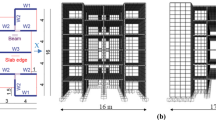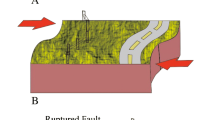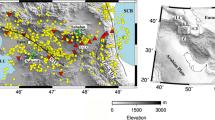Abstract
On the basis of the assumption that ω 2 model accords with source displacement spectra of moderate-small shocks, we calculate the apparent stress values of 1 020 moderate-small shocks recorded by the Digital Seismic Network of Yunnan Province by using the low-frequency flat level and corner frequencies. The results show that the apparent stress is of good significance in earthquake prediction. The moderate-small shock with apparent stress larger than 0.9 MPa can be used as a referential index to predict moderate-strong earthquakes in Yunnan area. And its relevant predictability evaluation (R value) has a high confidence level.
Similar content being viewed by others
References
Andrews D J. 1986. Objective determination of source parameters and similarity of earthquakes of different size [J]. Geophysical Monographs, 37(6): 259–267.
Atkinson G M and Mereu R F. 1992. The shape of ground motion attenuation curves in southeastern Canada [J]. Bull Seism Soc Amer, 82(5): 2 014–2 031.
Brune J N. 1970. Tectonic stress and the spectra of seismic shear waves from earthquake [J]. J Geophys Res, 75: 4 997–5 009.
Chael E P. 1987. Spectral scaling of earthquakes in the Miramichi region of New Brunswick [J]. Bull Seism Soc Amer, 77: 347–365.
Choy G L and Boatwright J L. 1995. Global patterns of radiated seismic energy and apparent stress [J]. J Geophys Res, 100: 18 205–18 228.
Department of Earthquake Monitoring and Prediction, China Earthquake Administration. 2005. Study on Short-term Precursory Features and Prediction of Strong Earthquakes in Southwestern China [M]. Beijing: Seismological Press: 33–35 (in Chinese).
GUO Zeng-jian and QIN Bao-yan. 1991. Seismogenesis and Earthquake Prediction [M]. Beijing: Seismological Press: 46–80 (in Chinese).
HE Zheng-qin, YE Tai-lan, SU Wei. 2004. S-wave velocity structure of the middle and upper crust in the Yunnan region [J]. Chinese J Geophys, 47(5): 838–844 (in Chinese).
HUANG Fu-ming and YI Zhi-gang. 2000. Relation between the evolution of seismic apparent strain field and the region of strong earthquake occurrence [J]. Acta Seismologica Sinica, 13(6): 616–627.
LIU Hong-gui, LIU Jie, DING Ye-ling, et al. 2006. Precursory specialties of apparent stresses in Yunnan earthquake series [J]. Acta Seismologica Sinica, 19(5): 497–506.
LIU Hong-gui, MIU Fa-jun, WU Jing. 2004. Simultaneous inversion of site response, source parameters, geometrical attenuation factors and inelastic coefficient of medium [J]. Earthquakes, 24(4): 27–36 (in Chinese).
Moya C A, Aguirre J, Irikura K. 2000. Inversion of source parameters and site effects from strong ground motion records using genetic algorithms [J]. Bull Seism Soc Amer, 90(4): 977–992.
Newman A V and Okal E A. 1998. Teleseismic estimates of radiated seismic energy: The E/M 0 discriminant for Tsunami earthquakes [J]. J Geophys Res, 103: 26 885–26 898.
Pulido N and Irikura K. 2000. Estimation of dynamic rupture parameters from the radiated seismic energy and apparent stress [J]. Geophys Res Lett, 27: 3 945–3 948.
QIN Jia-zheng and QIAN Xiao-dong. 2006. On temporal and spatial distribution of seismic apparent stresses in Yunnan area [J]. Acta Seismologica Sinica, 19(3): 233–242.
SU Sheng-rui, HUANG Run-qiu, WANG Shi-tian. 2002. Effect of Offset Structure on Stress Field and Its Application to Engineering [M]. Beijing: Science Press: 33–52 (in Chinese).
WU Zhong-liang, HUANG Jing, LIN Bi-cang. 2002. Distribution of apparent stress in Western China [J]. Acta Seismologica Sinica, 15(3): 309–317.
XU Shao-xie. 1989. The Evaluation of Earthquake Predictability [C]//Division of Monitoring and Prediction for Earthquake, State Seismological Bureau. Collection of Applied Research on Earthquake Prediction Methods. Beijing: Seismological Press: 586–590 (in Chinese).
ZHANG Guo-min, GENG Lu-ming, SHI Yao-lin. 1993. A computer model for cyclic activities of strong earthquake in continental seismic zones [J]. Earthquake Research in China, 9(1): 20–32 (in Chinese).
Author information
Authors and Affiliations
Corresponding author
Additional information
Foundation item: Project of National Natural Science Foundation (40574016), Joint Seismological Science Foundation of China (104047), and Science and Technological Planning Item of Social Development of Jiangsu Province (BS2005069).
Contribution No.07FE3012, Institute of Geophysics, China Earthquake Administration.
About this article
Cite this article
Liu, Hg., Wang, Pl., Yang, Cx. et al. Application of apparent stress in earthquake prediction. Acta Seimol. Sin. 20, 467–476 (2007). https://doi.org/10.1007/s11589-007-0467-3
Received:
Accepted:
Issue Date:
DOI: https://doi.org/10.1007/s11589-007-0467-3




